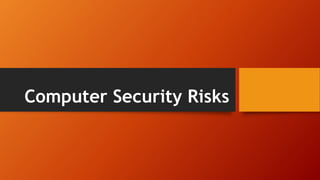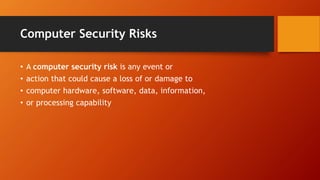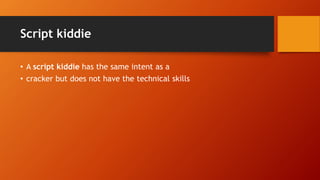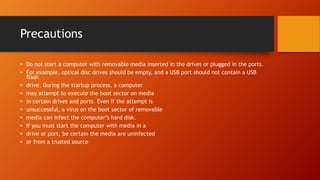Computer security risks
- 2. Computer Security Risks âĒ A computer security risk is any event or âĒ action that could cause a loss of or damage to âĒ computer hardware, software, data, information, âĒ or processing capability
- 3. Cybercrime Any illegal act involving a computer generally is referred to as a computer crime. The term cybercrime refers to online or Internet-based illegal acts. Software used by cybercriminals sometimes is called crimeware. Today, cybercrime is one of the FBIâs top three priorities.
- 4. Hacker âĒ Someone who accesses a âĒ computer or network illegally is called hacker. âĒ Some hackers âĒ claim the intent of their security breaches is âĒ to improve security.
- 5. Cracker âĒ A cracker also is someone who accesses âĒ a computer or network illegally but has âĒ the intent of destroying data, stealing âĒ information, or other malicious action. âĒ Both hackers and crackers have advanced âĒ computer and network skills.
- 6. Script kiddie âĒ A script kiddie has the same intent as a âĒ cracker but does not have the technical skills
- 7. Cyberextortionist (CRIMINAL LAW obtaining something by illegal threats) A cyberextortionist is someone who uses e-mail as a vehicle for extortion. These perpetrators send an organization a threatening e-mail message indicating they will expose confidential information, exploit a security flaw, or launch an attack that will compromise the organizationâs network â if they are not paid a sum of money.
- 8. Cyberterrorist âĒ A cyberterrorist is someone who uses the âĒ Internet or network to destroy or damage computers for political reasons. The âĒ cyberterrorist might target the nationâs air âĒ traffic control system, electricity-generating companies, or a telecommunications infrastructure. âĒ The term, cyberwarfare, describes an attack whose goal ranges from disabling a governmentâs computer network to crippling âĒ a country. Cyberterrorism and cyberwarfare usually require a team of highly skilled
- 9. Internet and Network Attacks âĒ Information transmitted over networks has a âĒ higher degree of security risk than information âĒ kept on an organizationâs premises. In an organization, âĒ network administrators usually take âĒ measures to protect a network from security âĒ risks. On the Internet, where no central administrator âĒ is present, the security risk is greater.
- 10. Security service âĒ To determine if your computer is vulnerable âĒ to an Internet or network attack, you âĒ could use an online security service. An online âĒ security service is a Web site that evaluates âĒ your computer to check for Internet and e-mail âĒ vulnera bilities
- 11. How virus can spread through Email Message
- 12. Safeguards against Computer Viruses and Other Malware âĒ Methods that guarantee a computer or âĒ network is safe from computer viruses and other âĒ malware simply do not exist. Users can take several âĒ precautions, however, to protect their home âĒ and work computers and mobile devices from âĒ these malicious infections
- 13. Precautions âĒ Do not start a computer with removable media inserted in the drives or plugged in the ports. âĒ For example, optical disc drives should be empty, and a USB port should not contain a USB flash âĒ drive. During the startup process, a computer âĒ may attempt to execute the boot sector on media âĒ in certain drives and ports. Even if the attempt is âĒ unsuccessful, a virus on the boot sector of removable âĒ media can infect the computerâs hard disk. âĒ If you must start the computer with media in a âĒ drive or port, be certain the media are uninfected âĒ or from a trusted source
- 14. Precautions âĒ Never open an e-mail attachment unless you âĒ are expecting the attachment and it is from a âĒ trusted source. If the e-mail message is from an âĒ unknown source or untrusted source, delete the âĒ e-mail message immediately â without opening âĒ or executing any attachments.
- 15. Precautions âĒ Some viruses are hidden in macros, which âĒ are instructions saved in software such as a word âĒ processing or spreadsheet program. In programs âĒ that allow users to write macros, you should set âĒ the macro security level so that the application âĒ software warns users that a document they are âĒ attempting to open contains a macro
- 16. Precautions âĒ Users should install an antivirus program and âĒ update it frequently. âĒ An antivirus program protects a computer against âĒ viruses by identifying and removing any computer âĒ viruses found in memory, on storage media, âĒ or on incoming files.
- 17. Precautions âĒ One technique that antivirus programs use to âĒ identify a virus is to look for virus signatures. A âĒ virus signature, also called a virus definition, is âĒ a known specific pattern of virus code. Computer âĒ users should update their antivirus programâs âĒ signature files regularly

















